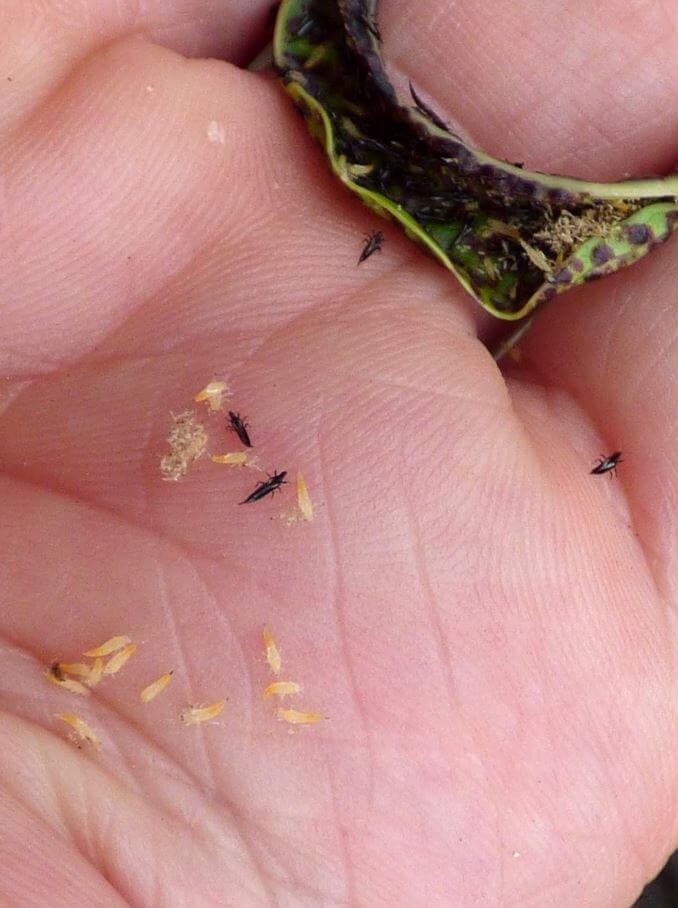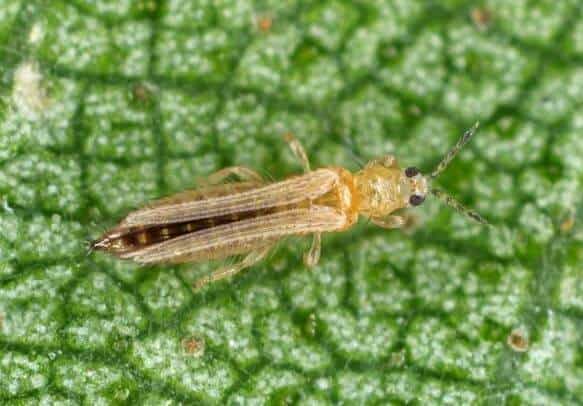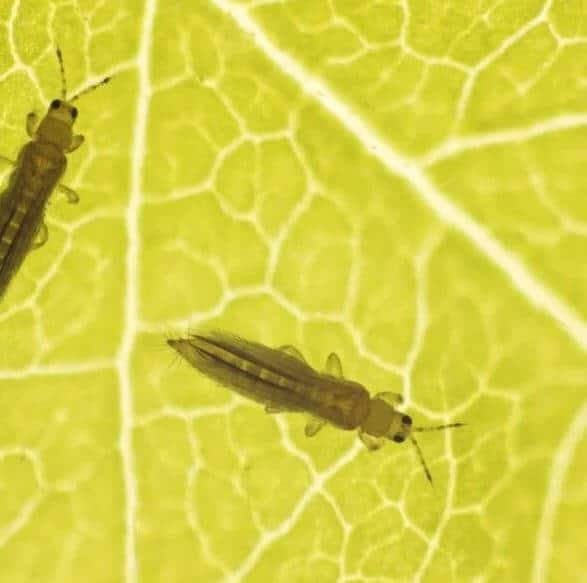Last Updated on September 9, 2023 by a Friendly Gardener
If thrips have recently invaded your houseplants or garden plants, you may wonder if these pests can survive if they do not have access to plants for feeding. Thrips feed primarily on plants. They often go undetected until the infestation is severe. They are tiny and will hide underneath foliage and in crevices where they may not be readily visible to the naked eye.
The survival of these insects and their lifespan depends on several factors. Beginning with the particular thrip species, environmental temperature, humidity, and their food source will all influence survival.
Can Thrips Live Without Plants?

These tiny pests, which generally measure less than 2mm lengthwise, are found in habitats featuring vegetation, including flowers, crops, and ornamental houseplants. They obtain necessary nutrients by feeding on plant sap, so their survival depends on finding plant material. All thrips will eventually die if they do not find some plant to feed on.
Thrips are members of the Thysanoptera order. Depending on the specific thrip species, their usual lifecycle will span from one to two months with these stages:
-
Eggs
Long, cylindrical eggs approximately 2 mm in length are deposited by the females inside plant tissue or on the surface of plant parts.
-
First instar larvae
With egg hatching, these tiny larvae appear. They have two pairs of legs and seem transparent. They feed on plant tissue by sucking sap after scraping the surface.
-
Second instar larvae
Approximately a week later, larvae grow a bit and develop color.
-
Pre-pupae
Several days later, the larvae transform again, becoming inactive and cease feeding.
-
Pupae
With this stage of development, the pupae are still not feeding and can be found on the soil surface or in foliage litter.
-
Adult
From a few days to several weeks, thrips emerge from within the pupae and generally have wings. They will mate and begin the reproduction cycle anew. Fertile females can lay as many as a few eggs per day, with some species producing as many as 50 eggs and a few species even more during their lifecycle.
How Long Can Thrips Live Without Plants?

Thrips often can survive for a few days without food, but the specific length of time will depend on the pest’s life stage when they are without a source of nutrition. They may be unable to reproduce or complete an average lifespan when food sources are lacking.
While adult thrips may survive for several days without food, active thrips may exhaust energy reserves much more quickly than a less active pest, so general health, age, and their reproductive stage will influence how long they can survive without food.
Plant Damage Caused by Thrips

Thrips can wreak havoc on crops and plants, so it’s essential that if and when their presence is noted, immediate intervention follows. They can cause significant damage, including:
-
Foilage damage
Thrips will scar plant foliage, causing them to turn white or brown and ruining the aesthetic of houseplants and ornamental plants.
-
Stunted plant growth
When feeding on plants, these pests can cause a plant’s flowers, foliage, and fruits to become stunted or distorted in shape and appearance.
-
A reduction in fruit quality
Thrip infestation also causes misshapen development with discoloration of fruit, ruining a fruit’s appearance. In the event of a crop infestation left without treatment, these pests can reduce a crop’s yield.
-
Transmission of plant diseases
Thrips are also known to be carriers of several plant viruses, such as Impatiens Necrotic Spot Virus or Tomato Spotted Wilt Virus, which can ruin a crop or plants.
What Attracts Thrips to Specific Plants?

Thrips enjoy stems, foliage, and flower buds that are tender in texture and rich in nutrition. Location temperatures and humidity levels can also influence their appearance on the scene. They prefer drier environmental conditions in warm climates. Research suggests that they are attracted to some colors more than others, such as yellow and blue, and may naturally gravitate to plants with flowers or plant parts in these colors. Generally, thrips will feed on an assortment of unrelated plants, although some species may zero in on specific plant types more than others.
Are There Plants that Naturally Repel Thrip Infestations?
Some plants appear to be less attractive to thrips and may aid in keeping them at a distance, especially in your garden, although there are more definitive solutions to thrip control. These include:
- Alliums (chives, garlic with sulfur compounds repel thrips)
- Basil (Ocimumbasilicum)
- Tagetes (Marigolds have compounds that appear to repel thrips)
Eliminating Thrips

Thrip infestations can be persistent, but there are a variety of methods used to rid plants and crops of these pesky critters.
-
Water
Spraying plants with a jet stream can aid in controlling thrips by removing them, but will not necessarily kill them.
-
Neem oil
This organic horticultural oil will interrupt thrip feeding and reproduction. It is a natural oil that is nontoxic for humans and pets.
-
Insecticidal Soap
Another nontoxic alternative is insecticidal soap sprayed on infected plants. The soap suffocates the thrips, killing them.
-
Beneficial Insects
Another natural method for eliminating a thrip infestation is by introducing beneficial predatory pests like ladybugs, lacewings, or predatory mites, which will reduce the thrip population.
-
Chemical pesticides
Pesticides with pyrethrin are especially effective in controlling thrip infestations.
In Conclusion
Thrips cannot live without plants, as vegetation is their primary source of nutrition and survival. They may last several days without food, however not much longer, and will succumb to a lack of nutrients. If your indoor or outdoor garden suffers a thrip infestation, act quickly to limit the damage these pests can inflict. Various natural, nontoxic, yet effective methods are available for protecting your plants.

